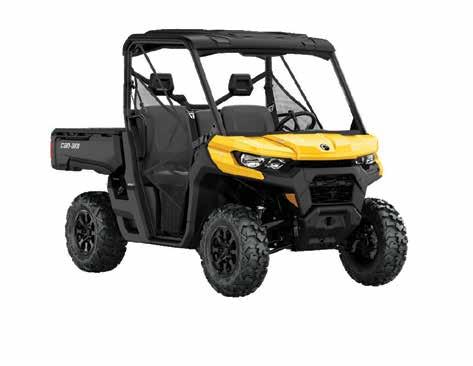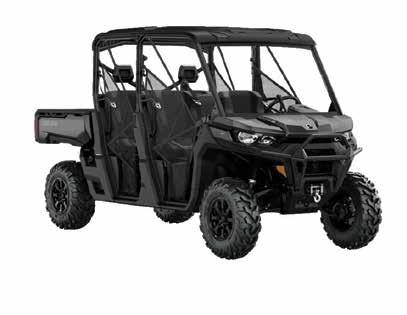






















SUDESH KISSUN sudeshk@ruralnews co nz
GROWING GLOBAL demand for dairy products and a flat milk supply could be setting the stage for a nearrecord farm gate milk price this season.
While it’s early days – there’s nine months left in the 2024-25 season – ANZ has lifted its forecast milk price to $9/kgMS. If this forecast comes to fruition, it will be the second highest milk price on record.
Federated Farmers dairy chair Richard McIntyre says a milk price of $9 would be a huge boost for farmers.
He told Dairy News that the last few years have been “pretty tight” on farm.
“There will be a long ‘wish list’ of things like plant replacement, environmental projects and debt repayments that farmers will happily sink any additional milk price into.
“That said, it’s still early days and a lot can change between now and next September when the final milk price is announced.”
ANZ agriculture economist Susan Kilsby notes that dairy commodity prices have trended higher in recent months as buyers have become more aware that there will not be a massive surplus of milk produced this season.

The major dairy-exporting countries are expected to produce a similar amount of milk this season to the previous season.
Meanwhile, demand for dairy products is continuing to steadily grow with the net impact is the firming of prices on Global Dairy Trade auction.
However, Kilsby has a word of caution – there is likely to be sig-
nificant volatility in prices as the season progresses.
“If a $9/kgMS milk price is achieved this season it will be the second-highest milk price on record,” she says.
“The previous record was the 2021-22 season milk price of $9.30/ kgMS.”
Fonterra is also optimistic about the season’s farm gate milk price,
lifting its mid-point by 50c to $8.50/ kgMS last month.
The co-op strong balance sheet also allows it to lift the season’s advance rate schedule by 10% from December. It’s earnings is now forecast to be at the top end of the announced range of 60-70 cents per share.
Fonterra chief executive Miles Hurrell says the announcements reflect the recent lift in GDT prices as well as the strength of the co-op’s balance sheet.
“Since announcing our opening financial year 25 season forecast farmgate milk price in May, GDT prices have improved. We’ve reflected this in our revised forecast range, with our midpoint lifting 50 cents to $8.50 per kgMS.”
“It’s still early in the season, with a relatively small proportion of our sales book contracted, so we are maintaining a wide forecast range,” says Hurrell.
The co-op’s new forecast range is $7.75-$9.25/kgMS, up from $7.25$8.75/kgMS.
“We’re also pleased to be announcing an uplift in our Advance Rate payment schedule, which will see farmers paid more for their milk earlier in the season,” Hurrell says.
“Our balance sheet strength has allowed us to make several enhancements to the Advance Rate schedule over the last two seasons.”
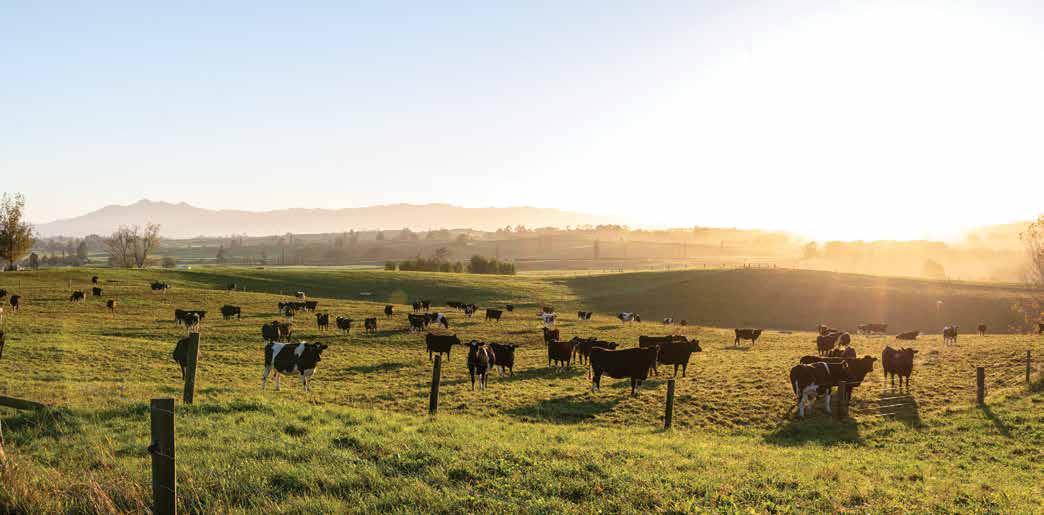
THE FARM consultant of the future will need to fully understand the various new emerging technologies and at the same time have good interpersonal skills to relate to clients.
That’s the essence of findings from Nuffield scholar and AgFirst chief executive James Allen about defining the role of the next generation agricultural consultants.
Speaking at the annual conference of the NZ Institute of Primary Industry Managers (NZIPIM) in Hamilton recently, Allen said the role of the farm consultant has changed over the years and that the pace of change is now quite rapid with such technologies as AI.
“The traditional role of the farm advisor has been one around tech extension or knowledge transfer. Now we are shifting to a position where knowledge is going to become more commoditised and you are going to be able to use ChatGPT or some AI search engines to find out what you want to know quickly,” he says
Allen says the farm consultant of the future must have a deep understanding of the various technologies and databases available and know how these can directly benefit the farmer client.
“The other bit is still the soft skills: the interpersonal skills, running businesses, working with families and driving that behaviour change.”
Allen says in the future there will be a continuation of the trend
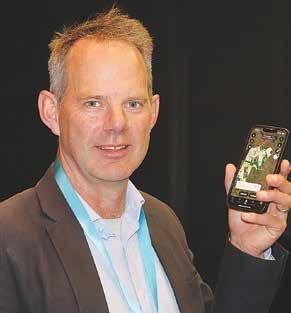
for fewer and larger farms and that most of these will be what he calls “family corporates”.
He says, compared to smaller farms, the larger farms tend to place more emphasis on reporting and information requirements.
He says the role of
the consultant will be to unscramble and make sense of data and present the information so that farmers can use it to make better decisions and improve their operations.
“AI and technology are here to stay, and people should not shy away from
it, rather just start experimenting with it and what it can do for their business.
“We are moving to precision agriculture whether we like it or not, so that goes down to managing the farm by the square metre and by the animal, not by the herd. Our farms are so big these days, we don’t understand what each sheep and cow is doing, but we now have technology to do that. In some ways it’s back to the old days, thanks to technology,” he says.
Technology in all its forms will likely mean some changes for the rural professional companies that service the farming industry.
James Allen points out that the days of a farm consultant sitting down with a calculator and working out covers
FONTERRA HAS climbed three places to number six on RaboResearch’s annual Global Dairy Top 20 report.
However, the co-operative’s plan to divest businesses in Sri Lanka, Australia and New Zealand means its position as the sixth ranked dairy processor in the world may be short lived.
Fonterra sits behind Lactalis, Nestlé, Dairy Farmers of America, Danone and Yili on the list.
Lactalis, with revenues of US$30 billion retains the top spot. European co-ops Arla Foods and FrieslandCampina sit seventh and eights respectively.
The report says Fonterra’s revenue jumped, lifting the cooperative’s ranking three places over last year.
While acknowledging performance was strong, the report notes that Fonterra’s financial year-end was July 31, 2023, meaning higher revenues likely reflect elevated commodity prices throughout the second half of 2022, which may have skewed the comparison to key global competitors with different financial year-end dates.
The report says Fonterra is unlikely to maintain sixth position in coming years given the cooperative’s strategic shift to focus on its core business and the potential for this to reduce future revenues.
“Fonterra announced ‘a step change in its strategic direction’ to be achieved via a pivot back to its core B2B ingredients and foodservice business,” the report says.
“This could include divesting some or all its consumer businesses, including Fonterra Oceania and Fonterra Sri Lanka.
“Fonterra stated that all its divisions are performing well but a shift to its core was the best strategy for the future.
“If all the considered divestments come to fruition, this could represent 15% of the co-op’s milksolids utilisation and 19% of the group’s earnings, representing a sale valued at more
than NZ$2 billion.”
and grass growth is over.
Most farmers can work this out for themselves thanks to automation.
But he says with new emerging technologies there will be a need for specialists.
He says the larger consultancies may employ specialists, while the small firms may retain their own niche.
“I think it will be a bit of both. For example, in AgFirst I have a ruminant nutritionist and an HR specialist and LEC mapper, so I can call on any of these specialists for a particular farm.
“We will continue to see an evolution of that, so you will see people with really specialist skills, but equally you still need that people person with strong business management skills to tie it all together,” he says.
Allen says he’s been
The report also notes a year of modest gains and strategic shifts within the dairy sector.
The report, which analyses the financial performance of the world’s leading dairy companies, indicates a slight 0.3% increase in combined turnover in US dollar terms, a stark contrast to the previous year’s 8.1% growth.
Fewer than half the companies listed maintained the same position as last year. Foreign exchange developments continue to impact the overall rankings, and limited mergers and acquisitions activity was again a key theme this year.

talking to universities around the country about the implications stemming from his report and he says, “they get it”. They are starting to think about how they can best meet the needs of industry in the future. He says while there may need to be changes to degree courses, it is essential for farm consultants of the future to have to have a core understanding of the basic principles of farming.
“The likes of an Ag Science or B Ag Com that gives an understanding of soils, pasture and livestock and how to integrate these is critical. What we need overlayed with that is a new set of skills around such things as database management, GIS software skills and getting the best out of AI technology,” he says.
The report attributes the deceleration in revenue growth to lower milk prices in 2023 compared to the robust values seen in 2022. This trend particularly affected European cooperatives, and seven companies worldwide reported lower revenues in their local currencies. Despite this, many companies have managed to report stronger profits and margins than in the previous year.
France’s Lactalis became the first company ever to exceed US$30bn in annual dairy-related revenue, an accomplishment that follows several years of significant revenue expansion through organic growth and acquisitions. – Sudesh Kissun


THERE ARE some positive signs coming from China regarding dairy, according to Stefan Vogel, general manager of Rabobank Research for Australasia.
Milk production in China is down, like many other parts of the world, due to rising cost of production, he points out.
Vogel says the Chinese
Government’s decision to lift domestic dairy production led to a substantial increase over the past five years.
But he says there are signs that this is slowing down, due in part to the higher cost of production which is hitting dairy farmers worldwide.
“We have seen a drop in milk production in other places such as the US, South America and the EU,” he told the NZ Institute of Primary

HERDS IN the West Coast settlement of Hari Hari are TB free after a fouryear battle to get on top of the area’s last outbreak.
However, to protect herds, further work is needed to ensure possum and other predator numbers are kept low enough to eradicate TB in the area, according to Ospri. In this outbreak, there were a total of 17 herd breakdowns of infection, making up a quarter of the total herds in the farming community. The movement control area includes 41 dairy herds.
“It’s a significant step for the community of Hari Hari, neighbouring areas in the West Coast region and the national TBfree plan,” says OSPRI new chief executive Sam McIvor.
“Getting rid of TB in their herds is a huge achievement that takes a systematic approach and coordinated effort over many years. It takes a team effort, and we work with the community and partner agencies to design and implement a disease control response plan that is tailored for their area.”
Over the past 30 years, there have been outbreaks in the farmland of Hari Hari following a 5–10 year cycle. Prior to the 2019 outbreak, there were no infected herds for four years.
As part of the disease control plan, major work carried out included regular
herd TB testing and significant amounts of possum control on farmland and surrounding areas of Hari Hari and the Waitaha Valley, using both ground and aerial possum control methods.
“Our surveillance of wildlife in the surrounding native bush shows us that the infection problem may remain in the Upper Whanganui, and that we do need to do another round of aerial treatment there to clean up the remaining infection, whilst also maintaining low possum numbers across the whole area,” says McIvor.
“TB is a resilient bug, and we need to keep our foot on the pedal to wipe it out.”
Over the coming years, disease control work will continue with regular monitoring and testing of livestock and wildlife for any signs of TB.
TB freedom in Hari Hari cattle brought the total number of TBinfected herds across the country down to 12, the lowest number on record. This compares to 1995 when there were an estimated 1700 TB-infected herds.
“The number of infected herds may bounce around a little bit but importantly, it is trending down overall. Ongoing biosecurity vigilance and ensuring NAIT records are up to date are critical ingredients in continuing our progress,” McIvor says.
Industry Management (NZIPIM).
“That could be good news and help the trade down the road,” he says.
“But dairy imports into China in 2025 may still be challenged and won’t be back to where we were two or three years ago, so that means challenging prices for a while longer,” he says.
Despite the ups and downs of the international dairy market, Vogel believes the future of the
NZ dairy industry will remain an important part of the country’s farming system.
He says the moves by government to seek new trade agreements and diversification into new markets will be a part of the new order.
He says NZ is in the top category of efficient dairy producers, but not the number one.
He says NZ is tracking well and moving in the right direction to meet
sustainability goals and deliver what the consumers want.
He says farmers in NZ, like those in Europe, have been given a bit of breathing space to reach the targets.
“When I went school, if somebody told me I had a little bit more time, I went to the playground rather than study. The message I have for NZ is this is not the time to go to the playground,” he says.
FONTERRA IS spending $75 million at its Studholme site in South Canterbury to boost high value protein production.
The co-operative says its proteins have enhanced functionality and are designed to perform well in premium product applications such as medical and high-protein sports nutrition.
The global high protein dairy category is projected to grow by close to US$10 billion over the next four years, at an annualised growth rate of 7% per annum.
Fonterra chief executive Miles Hurrell says the investment is part of the co-op’s strategy to grow value through its world-leading Ingredients business by partnering with customers who value Fonterra’s unique offering.
“We have valuable expertise in dairy science and innovation, making

“The expansion of our Studholme site will allow us to increase production of this high-value product.”
us leaders in the manufacture of dairy proteins and other advanced ingredient solutions.
“The expansion of our Studholme site will allow us to increase production of this high-value product and ultimately grow returns to farmers,” says Hurrell.
Fonterra president Global Markets Ingredients, Richard Allen, says the co-op’s dairy ingredients are highly sought after by customers globally.
“Increasing our manufacturing capacity for functional proteins will
enable us to continue to strengthen our offerings with existing customers as well as attract new business.”
Site works at Studholme will begin next month with the first product due to come off the line in 2026. In addition to producing advanced proteins, the site will continue to support the South Island’s milk processing as it has done since Fonterra acquired the site in 2012.
Allen says the project team reviewed Fonterra’s world-wide asset network before deciding on the Studholme site.
“It’s pleasing to see we are able to expand an existing site to produce these high value ingredi-

ents. The Studholme site was chosen as it is the right size, relatively new and had been built with future expansion in mind. It makes sense economically and we’re confident in the longevity of the site to supply these ingredients for the long term,” says Allen.
Fonterra expects six new roles at the site will be created as a result of this project and a large number of contractors involved in the build will come from the Canterbury region.
The project will also support the conversion of Studholme’s existing coal boiler to a coal-free alternative in line with Fonterra’s commitment to exit coal by 2037.

that report, it’ll draft her out. It’s as easy as that, really.
WITH MATING season just around the corner, Darfield dairy farmer Daniel Schat says activitymonitoring collars have been a game changer on his farm.
Schat is now into his fourth season of using MSD Allflex collars in conjunction with an Allflex automated drafting gate on his herringbone shed.
While he says it takes a year to really figure out how best to use the system, last year he had his best mating ever, with just 10.5% empty.
The software’s algorithm looks for a spike in activity and a drop in rumination to identify when a cow is in heat, and gives them a score out of 100.
“So, if she comes onto
“It allows you to not have to be there every morning drafting cows. You can rely on the system just to have the cows ready for you.”
Schat uses no tail paint or any other backup for heat detection.
“We found we just trusted it right from the start.”
Schat notes that other systems are available, but he chose Allflex because he originally had no automation in the shed whatsoever. Going with Allflex for both the drafting gate and collars meant that any issue was an easy fix.
The former sharemilker is now into the seventh season on his own farm, peak milking about 365 cows on 103 hectares effective.
With the collars, he

is exclusively using AI, which he administers himself.
Schat says that at the start at the start of the season the system needs about a week of data to get a trend and set a baseline.
The cows that have
just calved are ideally held on once-a-day milking until the collars show they are ready to join the twice-a-day main herd.
“Once she’s calved, then I’m looking more for the rumination. Is she eating properly and ruminating properly?


“If I’m being good, I should be holding them back if they’re not over 380 [minutes a day rumination].
“This year we haven’t had the feed round, and management-wise it’s just been easier that after four days, we sent them to the
milkers.
“But we have done it in the past where if they weren’t ruminating above 380 minutes that we would just hold them back on once a day for a little bit longer.”
Schat will start AI on October 23 but recommends putting the cows through the drafting gates for about three weeks before mating proper begins.
“Especially the twoyear-olds, they don’t know what they’re doing. So, they just get used to doing it, so that when it happens for AI for real, they know, ‘this is normal, I’ve done this before’.
“When we’re practising, I just do it once a day, but we draft twice a day when I am actually breeding.”
Morning and night AI increases the chances of
catching the cow at the peak of the cycle.
Schat notes that in the US it would be normal for a farmer to observe a long stand-down period but New Zealand’s seasonal industry needs to get as many cows as possible calving early – so he will inseminate even a late-calving cow having only her first heat right at the start of mating.
“Is she gonna hold? Possibly not. But I’m still gonna give it a go.”
Schat also does a lot of embryo work and says the collars allow him to pick the best cows for implantation.
“You’re creating quite valuable embryos that you don’t want to go and put into a cow that is just on heat for the first time. Whereas I can go back on the collars and say, oh, she had three, she’s had three good strong ones.”
A METHANE inhibiting bolus specifically suited to New Zealand’s pastoral farming system is awaiting regulatory approval for a launch late next year.
The slow-release, biodegradable bolus developed by Ruminant BioTech sits in the animal’s rumen, releasing a controlled dose of a methane inhibitor for up to six months.
The latest trial on cattle reportedly showed impressive results, with a 75% daily methane reduction for 100 days from a single treatment.
The technology has received a $4 million funding boost from AgriZeroNZ, an industry joint venture between the Government and leading agribusiness companies in New Zealand, including Fonterra.
AgriZeroNZ chief executive Wayne McNee says the public-private joint venture is pleased to boost its investment in Ruminant BioTech by $4 million, on top of an initial investment of $1.8 million in April 2023.
“Ruminant BioTech is proving its technology is working – on animals and in New Zealand – so we’re pleased to make this further investment to accelerate the development of a pasture-based solution for Kiwi farmers.
“The bolus has demonstrated world-leading results for methane reduction in a pastoral system in its latest animal trial, and we look forward to supporting the team to make their emissions reduction tool available to farmers.”
Ruminant BioTech chief executive Tom Breen says his company is working with MPI on full product reg-
istration to enable the methane-inhibiting bolus to be used on New Zealand farms.
Breen says the company aims to be treating over 30 million cattle annually by 2030 and envisages this increasing to 100 million cattle within the next 10 years.
“This additional funding from AgriZeroNZ will help us accelerate our product and market development programme and build our first manufacturing plant in New Zealand to bring the product to market in late 2025, starting in Australia and followed by New Zealand, subject to regulatory approvals.”
McNee believes the bolus could be a game-changing tool to help farmers reduce emissions without changing farming practices.
“The bolus application holds huge promise for providing Kiwi farmers with a solution that’s practical and effective.
“It has the potential to be suitable for all ruminant animals, and due to its low touch nature, it’s also a viable option for the likes of beef farmers who don’t need to interact with their animals daily.”
AgriZeroNZ has committed more than $34 million across a range of emissions reduction tools and technologies for New Zealand farmers including novel probiotics, low methane pasture and methane vaccines.
“There isn’t going to be a one-sizefits-all approach when it comes to reducing emissions across our agricultural sector.,” McNee says.
NEW RESEARCH has revealed a worrying statistic: fewer than half of veterinarians in New Zealand intend to stay in the profession until retirement.
The “Taking Animal Health Forward” white paper launched by global animal health company Boehringer Ingelheim highlights the critical challenges facing New Zealand’s animal health sector.
The research shows the need for greater awareness of the vital role played by veterinary professionals, along with more funding and mental health support needed to ensure the sector, estimated at $12 billion of economic value, enjoys a more sustainable future for the benefit of New Zealand.
Celebrating more than 50 years of service in New Zealand, Boehringer Ingelheim has partnered with the New Zealand Veterinary Association (NZVA) and the New Zealand Veterinary Nurs-
OTHER RECOMMENDATIONS include increased government support for veterinary training, recommending higher tuition subsidies for veterinary science students and the establishment of apprenticeship models to attract new talent
This echoes similar recommendations from a New South Wales parliamentary committee, which identified similar issues affecting the sector across the Tasman
Paul Fitzpatrick says there was also a job for the sector to do in ensuring veterinary health professionals felt valued and supported in the workplace
“Providing increased support for ongoing education and professional development is crucial to retaining people longer, boosting wellbeing and creating more sustainable businesses
“Encouraging flexible work arrangements that effectively support individuals of all genders is especially beneficial for the veterinary nursing sector, where 985 of professionals are women
“We know solving these challenges cannot be, and will not be, a one-size-fits-all approach However, this research shows how we can make a real difference to our sector, and to the future of all New Zealanders We’re committed to helping things move in the right direction and lay the foundations for a thriving and sustainable animal health sector for the next 50 years and more,” he says
ing Association (NZVNA) to develop comprehensive research based on insights from over 600 veterinary professionals across the country. This
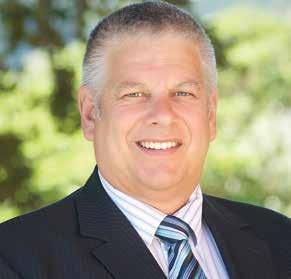
40% of veterinarians and 26% of veterinary nurses surveyed expected to remain in the profession until retirement. Burnout and mental health pressures are driving many out of the field, and 43% of clinic decision-makers report difficulties in hiring skilled staff.
included veterinarians, veterinary nurses and veterinary technicians.
The “Taking Animal Health Forward” white paper shows that only
AGRICULTURE AND Overseas Trade
Minister Todd McClay says his government is pulling out all the stops to get a trade deal with India.
He told delegates to the recent NZ Institute of Primary Industry Management (NZIPIM) conference that he has personally made three visits to India since National took office late last year. He was there a few weeks ago where he met his counterpart Piyush Goyal, the Indian Minister of Commerce. McClay says there are challenges when a country the size of NZ with just over five million people tries to deal with a country with a population of 1.4 billion.
“But while there I made the case again that whenever NZ does a trade deal, we are often much smaller than our partner,” he says.
“Recent examples of this are the FTAs with the UK and the EU which provide for a high-quality set of rules that gave business on both sides certainty. There are lots of opportunities for NZ in India in the primary and services sectors and there are equally good opportunities for India to do more business in NZ,” he says.
McClay says an exciting development has been the decision of India to
use NZ wool carpet in its parliament –an example of how trade could further develop. He says, for the last few years, the relationship between India and NZ has been underdone, but the trajectory is changing with the March 2024 visit to India by Deputy Prime Minister Winston Peters and a planned trade mission to be led by Prime Minister Luxon later this year.
This move to target India is backed by Sir Lockwood Smith, former politician, who says NZ must get a trade deal with India.
Smith says the Government is right in making India a priority to pursue this. He says such a deal may not be big for agriculture, especially the dairy industry, but over time “we can work with their dairy industry to help them build their own dairy industry as a start to open the door for us”.
While it’s now widely accepted that the days of FTAs such as the one with the UK are probably over, Smith says there are other ways that NZ can improve quality access for its exports. He says NZ has huge influence on trade matters globally and our top trade negotiator, Vangelis Vitalis, is highly regarded internationally. – Peter Burke
Paul Fitzpatrick, head of animal health New Zealand at Boehringer Ingelheim, underscored the urgency of addressing these issues, not just for the profession, but for the wellbeing of all New Zealanders.
“The health of New Zealand’s economy is intrinsically linked to the health and welfare of its animals. Veterinarians and other animal health professionals are on the frontlines of our biosecurity defences, protecting our incredibly valuable agriculture industry,” he said.
“To maintain the health of our nation, it’s essential to understand the complex challenges our industry faces, address public perceptions and chart a sustainable path forward.”
The whitepaper highlights lack of public understanding about the value of the veterinary profession as a significant factor in practitioners’ stress and fatigue. The research indicates that 70% of animal health practitioners believe the true scope of their work is not well understood or appreciated, rising to 88% of veterinary nurses.
Many rural veterinarians are performing a consultancy role on behalf of farming clients, such as how to improve fertility and growth, advice on breeding and selecting alternatives for certain geographies, and much more.
Kevin Bryant, CEO of NZVA notes that fully leveraging the training and knowledge of veterinarians, veterinary technicians and veterinary nurses to support business growth and resilience is an untapped opportunity for this country.
“We’ll spend hundreds on our own dental
work, but a similar veterinary treatment, which requires similar skill and equipment, is considered too expensive, even at a much lower cost. It comes down to public perceptions of value, and it’s clear there’s a disconnect between the reality of costs and what the general public understands about how these costs are generated.”
The white paper also calls for legislation to enable allied veterinary professionals (AVPs) to take on more skilled work.
Laura Harvey, president of NZVNA, says that globally they are seeing more AVPs taking on new roles and responsibilities.
She says regulation of AVPs in New Zealand is one way to help relieve the ongoing staffing shortage.
“Robust legislation may give workplaces the confidence to fully embrace the skills that veterinary nurses and veterinary technicians bring to the table.”



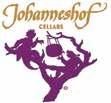
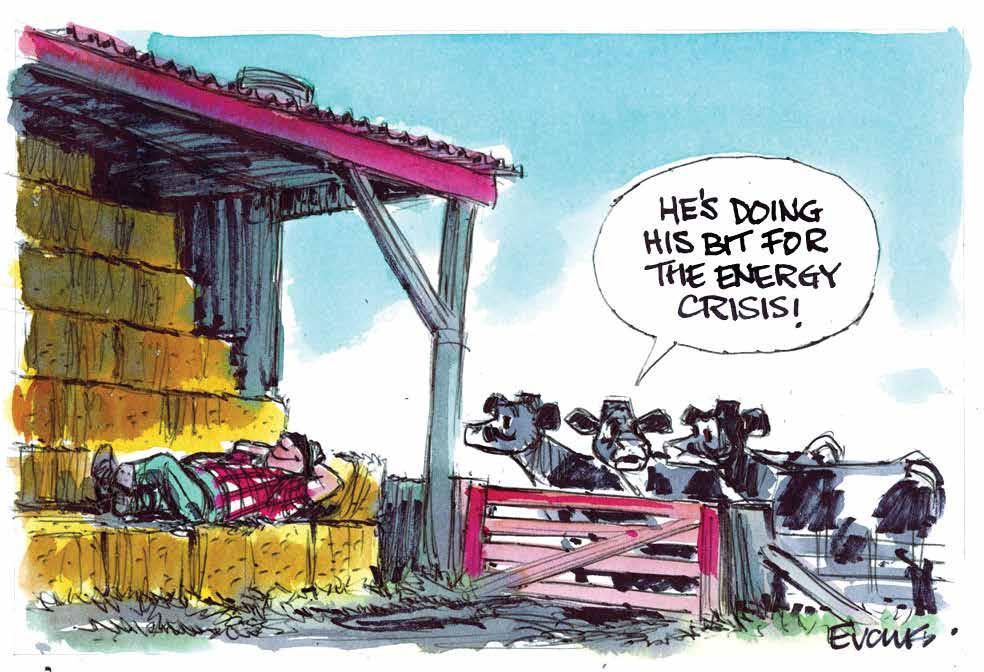
THE LATE Sir Rob Muldoon once famously quipped that the plane loads of Kiwis jumping the ditch to live in Australia “raised the IQ of both countries”
The ‘brain drain’ to Aus continues, with a net migration loss of 27,000 people from NZ to Australia in 2023, says Stats NZ Curious to see if the grass is greener for dairy farmers considering the lucky country, an Aussie analyst found that, on average, ‘VIC/TAS irrigated’ farmland cost AU$26,250/ ha versus ‘NZ irrigated’ at AU$48,000; wintering costs in Tasmania are $27/cow/week versus $40/cow/week in NZ; and NZ has more ‘red tape’ On the flip side, NZ’s cost of production is lower and Aus has both stamp duty & capital gains tax His summary: “farming is bloody tough anywhere!”
MILKING IT understands the parliamentary inquiry into banking is already having an impact
Reports are coming in of some South Island farmers being offered loans with interest rates of 5 7% and 5 8% Just for context, most farmers are on interest rates over 8%
Whether the banks are feeling the heat or it’s just a public relations exercise remains to be seen
Federated Farmers says the banks have a long way to go before they earn back the trust of farmers
A Federated Farmers survey shows that farmers’ satisfaction with their banks has dropped to its lowest levels since their surveys began in May 2015 Six years ago, around 80% of farmers were satisfied with their bank, but that number has since plummeted to just 51%
IT SEEMS that our friends at Greenpeace are never satisfied
The Government’s plan to overhaul restrictions of gene editing and other genetic technologies in New Zealand and establish a dedicated regulator has been well received The new genetic technology could be the key to reducing emissions in the pastoral sector
However, Greenpeace remains adamant that genetically engineered “technofixes are not the solution”
Sounding like a broken record, they are still calling for fewer cows and less palm kernel feed and nitrogen fertiliser
In case Greenpeace hasn’t noticed, even Organics
Aotearoa New Zealand (OANZ) has welcomed discussions to review gene technology rules to meet changes in scientific advancements
Painting the cow red HOW DO you get people to stop drinking milk and switch to foods like fruit, vegetables, nuts and grains?
The simple answer is that you can’t But try telling that to animal welfare group Taranaki Animal Save
Last month, their activists have covered the iconic cow statue at Fonterra’s Whareroa plant in Taranaki with red paint and hung a “dairy kills” sign from its neck to commemorate Bobby Calf Awareness Day It was to highlight the plight of bobby calves, they say
But the industry is already working to improve its treatment of bobby calves: Fonterra farmers must ensure all nonreplacement calves enter a value stream – either beef, calf-veal (bobby) or pet food; and calves are only euthanised on-farm when there are humane reasons for doing so
THERE’S GROWING confidence that dairy prices are firming up.
Last month, Fonterra lifted its forecast farmgate milk price mid-point to $8.50/kgMS and unveiled a new forecast range of $7.75 to $9.25/kgMS.
ANZ came out a few days later, raising its forecast milk price to $9/kgMS, which if achieved, will be the second-highest milk price on record.
The previous record was the 2021-22 season milk price of $9.30/kgMS.
The higher dairy prices can be attributed to factors such as little or no increase in milk production around the globe, including China, and firming demand. As usual, China remains the key.
Earlier this year, Chinese dairy purchases were at a 12-year low. There have been large increases in Chinese domestic dairy production, spurred on by the Chinese government. However, higher production costs and lower prices are slowing China’s domestic milk production.
This has seen China come back to the Global Dairy Trade and buy a little bit more. There’s also talk that the Chinese government might encourage some dairy herd reduction to boost farm gate prices, which could lead to some additional imports.
For New Zealand farmers, things are looking up, however, higher interest rates remain a major challenge.
The average breakeven price assessed by DairyNZ for last season is $7.93/kgMS. The average breakeven price for the 202425 season is expected to creep back up to $8.07/kgMS with increased debt repayments and tax.
A $9 milk price will provide much-needed relief to farmers. For some it may prompt a little more spending on items such as repairs and maintenance, particularly work deferred due to low returns.
Still, the 2024-25 season has another nine months to run. Volatility will remain, but there is a good chance of prices firming.
Head Office: Lower Ground Floor, 29 Northcroft St, Takapuna, Auckland 0622
Phone 09-307 0399.
Postal Address: PO Box 331100, Takapuna, Auckland 0740 Published by: Rural News Group Printed by: Inkwise NZ Ltd Contacts: Editorial: sudeshk@ruralnews.co.nz Advertising material: davef@ruralnews.co.nz
Rural News on-line: www.ruralnews.co.nz
Subscriptions: subsrndn@ruralnews.co.nz
Publisher: Brian Hight Ph 09-307 0399
General Manager: Adam Fricker Ph 021-842 226
Editor: Sudesh Kissun Ph 021-963 177
Machinery Editor: Mark Daniel Ph 021-906 723
markd@ruralnews.co.nz
Reporters: Peter Burke Ph 021-224 2184 peterb@ruralnews.co.nz
Subscriptions: Julie Beech Ph 021-190 3144
Production: Dave Ferguson Ph 027-272 5372
Becky Williams Ph 021-100 4831
Digital Strategist: Jessica Marshall Ph 021 0232 6446
AUCKLAND SALES CONTACT: Stephen Pollard Ph 021-963 166 stephenp@ruralnews.co.nz
WAIKATO & WELLINGTON SALES CONTACT: Lisa Wise Ph 027-369 9218 lisaw@ruralnews.co.nz
SOUTH ISLAND SALES REPRESENTATIVE: Kaye Sutherland Ph 021-221 1994 kayes@ruralnews.co.nz


WELL-MADE, HIGHQUALITY grass silage is one of the most valuable feeds available to farmers.
It is high in energy and protein, and as a stored feed it can be one of the most flexible feeds in the farmer’s toolbox to fill summer feed deficits.
Conserving high-quality pasture silage during feed surplus periods is a crucial skill in pasture management. We see a huge variation in the quality of grass silage made each season, but some farmers can get it right most seasons, when others struggle. So, what management factors help ensure good quality pasture silage is harvested?
Identify pasture surplus early
There are a variety of ways for early identification of a pasture surplus on farm.
Your pre grazing covers are higher than your target.
2.8 cows/ha * 18 kgDM/ cow * 25 day rotation + 1500 kgDM/ha residual = 2760 kgDM/ha
In this example when you see pre grazing pasture cover going above 2760 kgDM/ha you have an option to remove these paddocks from the rotation.
Your pasture growth rates are greater than your pasture demand.
2.8 cows/ha * 18 kgDM/ cow = 50 kgDM/d growth rate
In this example if you are measuring pasture growth rates above 50 kgDM/d then you can start to look at removing paddocks from the grazing rotation.
Your average pasture cover is greater than your target.
From the example above, if your pre-grazing trigger level is 2760 kgDM/ha and your post grazing target is 1500 kgDM/ha, when your average pasture cover exceeds the mid-point (2130 kgDM/ha) you can start to look at removing paddocks from the rotation.
Your feed wedge identifies paddocks above the line.
If you are doing regular pasture walks the feed wedge can illustrate an emerging surplus (Figure 1). This early identifica-

tion will give you some lead time to communicate with your contractor and book in advance.
Communicate
Communicate early with your contractor so that they have an idea of when you are likely to need your surplus harvested. You want to be first in the queue to reduce the risk of delays as demand for contractors increase. Let them know your needs and expectations.
Harvest
Ensure that the grass is cut while quality is still high. Many farmers make the mistake of going for quantity over quality. Silage needs to be har vested at the right time to optimise quality and quantity, ideally no later than 42 days after the last grazing.
Ideally harvest after 2-3 days of fine weather and once harvested wilt to at least 30% dry matter. This concen trates the plant sugars and reduces the risk of nutrients being lost from the silage stack as run-off. Use the “Squeeze Test” to determine ideal chop length. Grab a hand ful of chopped grass and squeeze hard. If mois ture runs out, chop the silage longer. If your hand remains dry, chop it shorter.
Store

You want to get the air out of the stack as quickly as possible. This ensures that the bacteria in the inoculant get to work straight away and produce as much lactic acid as possible. For stacked silage, spread material into 100 - 150mm layers and compact until the surface is firm. Use a
high-quality plastic cover and weigh it down with tyres that are touching. Seal the edges with sand or lime.
The importance of a high-quality pasture silage cannot be overstated. It is a fantastic farm systems feed that is valuable for increasing milk production and complimen-
tary to other feeds such as maize silage. In contrast, poor-quality silage is an expensive filler for dry cows. The difference in quality is largely up to things most farmers can control.
• Wade Bell is Genetic Technologies farm systems manager. Contact him at wbell@genetic.co.nz.

Pasture silage can be challenging to ensile. It has a higher buffering capacity which means more acid is required to reduce the pH. Adding a quality silage inoculant like Pioneer brand 1127 assists with a fast, effi cient fermentation and minimises energy and protein losses during ensiling. Quality inocu lants come from repu table companies, have label claims as to the number of live bacte ria, are backed up by trial data and are supported by those people selling them.

HAMILTON-BASED HILL
Labs has introduced a new test to detect earthworm eDNA levels in soils, claiming that it marks a significant development in soil health assessment.
This test, developed in collaboration with AgResearch, is a New Zealand first and represents the beginning of an array of potential applications to provide real benefits across the agricultural sector.
Earthworms are often seen as indicators of healthy soil because they need good soil conditions to thrive. They also aid in aeration and nutrient mixing. In high-quality soil, a typical New Zealand paddock would usually have earthworm populations exceeding 400 per square metre and 250 per square metre in
arable land.
Hill Labs’ earthworm eDNA test measures environmental DNA (eDNA) – tiny traces of genetic material left behind as earthworms move through the soil.
Existing methods to assess earthworm populations are labour-intensive and require specialist knowledge, limiting the number of samples and convenience. A typical field visual assessment involves digging down about 20cm with a spade, then taking a second slice about 35cm away to get a clear sample. The soil is broken apart with all worms picked out, counted and the species identified.
The new eDNA test, used in tandem with existing field visual assessments, offers a convenient way to enhance


Fully Escorted Tours
Tailor-made for the 60 plus traveller
Calgary Stampede & The Rocky Mountains
Jul 5th, 2025, 16 Days
Embark on a 16-day adventure through the heart of Canada's stunning landscapes and vibrant culture. Experience the thrill of the Calgary Stampede - world-class rodeo action and the Chuckwagon event.
Indulge in luxury aboard the Rocky Mountaineer Train from Banff to Vancouver, passing through the majestic Continental Divide. Discover the natural

soil health monitoring.
Hill Labs founder and executive director, Dr Roger Hill, played a large role in developing the test.
Hill says soil is the foundation of all life, essential for productive farming, healthy plants, and clean waterways.
“Our new earthworm eDNA test gives farmers an additional tool to better monitor soil health, helping to promote sustainable farming in New Zealand and beyond.
“The biological component of soil health is difficult to measure and
ALTERNATIVE TOOLS are increasingly available for growers looking to reduce their reliance on agrichemicals in response to market and resistance challenges, says Foundation for Arable Research chief executive Alison Stewart.
Many of these, including biologicals and digital decision-support tools, were outlined at a FAR-organised series of events titled: “A Lighter Touch: a new approach to crop protection”.
The $27 million, seven-year “A Lighter Touch” (ALT) programme was established in 2020 to develop and promote arable and horticultural pest management options which reduce reliance on synthetic chemistry. It is jointly funded by government and industry.
measuring earthworms provides a high-level view of a soil’s biological health.
“And this successful earthworm eDNA soil test is just the beginning. We’re dedicated to exploring the full potential of this technology across different crops and
farming methods to support New Zealand’s farmers and growers.”
Hill Labs scientists, Lisa Hsu and Sara Loeffen, worked closely with AgResearch senior scientist and leading earthworm specialist, Dr. Nicole Schon, on this project, with the initial
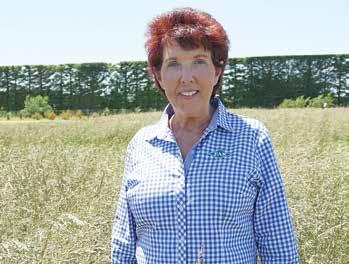
by increasing consumer pressure, the build-up of resistance to existing agrichemicals and a reduction in new chemistry being registered in New Zealand.
years at current annual growth rates.”
Already in the US, about 70% of biologicals are sold to conventional farmers.
feasibility study funded by the Our Land and Water National Science Challenge via its Rural Professionals Fund.
Schon says that through research they are learning a lot more about soil health and the need to move beyond the limited set of measures and indicators that people used to rely on.
“This provides us with a richer understanding of what we can do to maintain or improve soil health for our primary industries.
“We know that the abundance of earthworms and other biological activity is an important component for healthy soils, and having this new tool for testing the abundance of earthworms via eDNA is going to make measuring soil health easier and more efficient.”
and use of resistant cultivars, mechanical practices, precision agriculture and digital support and monitoring, as well as plant protection products.
“We still need agrichemicals. Ultimately our goal is to maintain the effective life of these products,” Drummond says.
“There is no option now but to layer up these strategies that can help growers successfully reduce their input costs and maintain or potentially increase profitability and yield.”
As a first step, growers need to pick a resistant cultivar.
They also need to consider, understand and prioritise agrichemical application timings to reduce costs and protect existing chemistry.

Stewart says FAR has had a crop protection research programme centred around the use of agrichemicals since its inception almost 30 years ago “but we will not necessarily have that luxury into the future”.

“The challenge is how do we take our intensive arable agrichemical system and transition that to something that has a ‘A Lighter Touch’.”
While agrichemicals are critical to management of pests and diseases in arable production systems, their use and availability is being challenged
ALT industry stakeholder advisory group chairman Dr Stuart Davis told the Ashburton event that an impetus for the programme is the rapidly growing availability of biological products which will assist growers to transition into softer chemistry.
While new synthetic chemistry can cost US$300 million and 11 years to develop for market, biologicals can be available in less than five years at a development cost of around US$5m.
“In the US, it is predicted that the biologicals market could be as big as agrichemicals in 20
In New Zealand, delays in getting approval for new products is causing frustration and the regulatory process is currently being reviewed by government. “Biologicals need to be assessed and approved faster than they are now,” Davis says.
FAR senior cereals researcher Jo Drummond says that while attracting premiums for using less and softer chemistry may be easier in sectors like horticulture or wine, for arable it may be more about market access.
Crop protection practices for present and future include biological control, plant breeding
“Do your homework on biopesticides and biological products and be realistic. You can’t just switch one product for another.”
Decision support tools such as FAR’s online Aphid Chat are also available to assist with treatment timings, Jo Drummond says.
Visiting United Kingdom plant pathologist Dr Aoife O’Driscoll told the ALT events that increasing fungicide resistance, combined with rapidly rising fungicide costs is driving UK cereal growers to change their crop management.
CRV HAS produced the first homozygous polled bull to make New Zealand’s prestigious Ranking of Active Sires (RAS) list, demonstrating the strides the company is making in breeding topquality polled bulls.
The Jersey bull, Gym, is currently ranked 31 on the RAS list with a Breeding Worth (BW) of 464 (August 2024). Gym boasts size, and capacity, and excels in health and production traits.
Gym was bred by Gordon Ferguson of Horopito Jerseys from Ross on the West Coast, a long-time supporter of polled genetics. CRV genetics product manager Mitchell Koot says Gym’s
place on the RAS list shows that genetic excellence and polled traits can go hand in hand.
“Gym’s place on the RAS list means farmers can breed for polled (hornless), without sacrificing genetic merit,” says Koot.
He says breeding highquality polled bulls has been a focus for CRV as the company seeks to support New Zealand farmers who are committed to the highest animal welfare standards, wanting to lower their costs and meet the needs of changing consumer preferences.
Calves born without horns remove the need for disbudding, improv-

ing animal welfare, and reducing labour and costs, says Mitchell.
“Gym has size and capacity to go with his excellent health and production traits, resulting in him being one of our
top 10 selling Jerseys this season, which reflects the quality and demand for this polled bull.”
Koot says CRV has made a significant investment in its polled breeding programmes
internationally across Holland and the USA.
That work, combined with CRV’s efforts in New Zealand is paying farmers dividends with plenty of high-quality polled bull options to choose from.
CRV’s catalogue now features 27 polled bulls across the main breeds Friesian, Jersey, and crossbred, nearly tripling the options from four years ago when only 11 polled bulls featured.
“New Zealand dairy farmers now have much greater choice of polled bulls for their breeding programmes. With 20 per cent of our bull breeders now using polled genetics and increasing adoption of technologies like embryo transfer, one of the fastest ways to accelerate genetic gain, the future looks promising for high-genetic-merit polled bulls,” says Koot.
April and Jason Dibble now own the herd that
Gym was bred from and are continuing the legacy. They have more contract matings with CRV this season and they also used Gym as a sire on some of their herd this year.
“If you can remove the need to dehorn or to disbud, that is good for animal health and the farmer. We’re proud to continue supporting CRV and build on the good work of Gordon, our herd’s previous owner, to improve polled genetics,” says April.
“Good genetics are everything. It’s not just about breeding worth. To get a bull-like Gym that is polled and with other valuable traits, is great to see.”
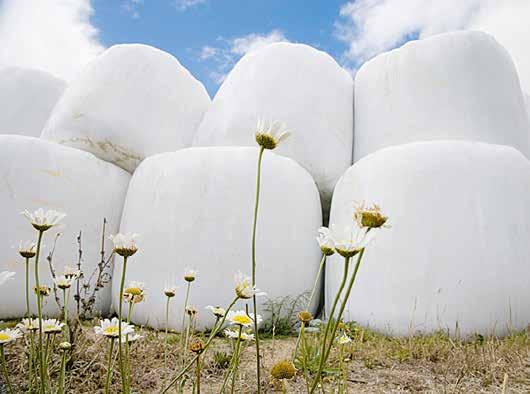
GOOD EFFLUENT man-
agement on the dairy farm combines a welldesigned system with proper processes to ensure the right amount of effluent gets applied to pasture at the right time.
This not only saves on fertiliser costs and enhances soil health but also helps prevent animal health problems and ensures compliance with local rules.
Understanding soil water deficit is crucial to prevent run-off and applying effluent to saturated soils.
There are tools available, such as the DairyNZ farm dairy effluent spreading calculator, to help manage the application of effluent nutrients with precision.
Finally, regular maintenance of your irrigation application equipment is vital for optimal performance.
Good effluent management is a combination of having a well-designed effluent system and processes for people that
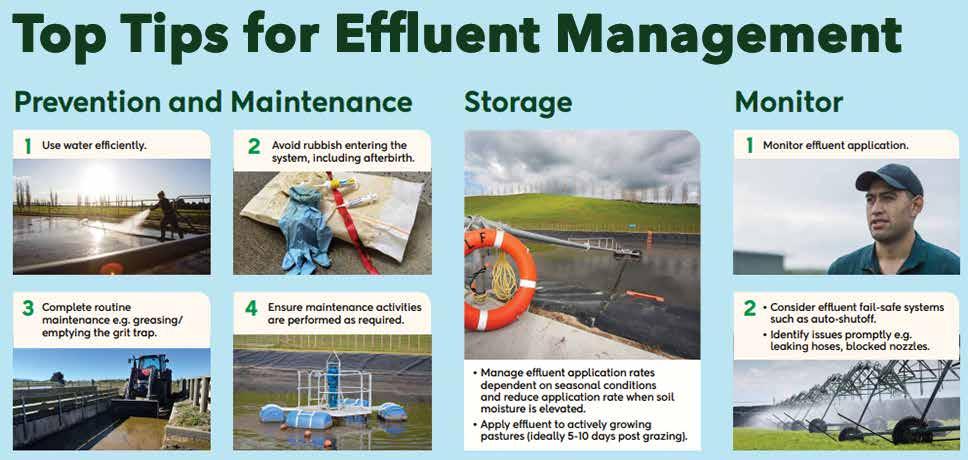
make sure the effluent the system collects is applied to pasture in the right amount at the right time.
On-farm benefits of good effluent management include:
■ Fertiliser savings
■ Improved soil condition
■ Prevention of animalhealth issues
■ Compliance with council rules or
resource consent
Making good effluent irrigation decisions
The key to good decision making is understanding the soil water deficit. It is essential to prevent ponding and runoff and to avoid applying effluent to saturated soils.
Soil water deficit is the amount of water (effluent) which can be applied to the soil before it reaches field capac-
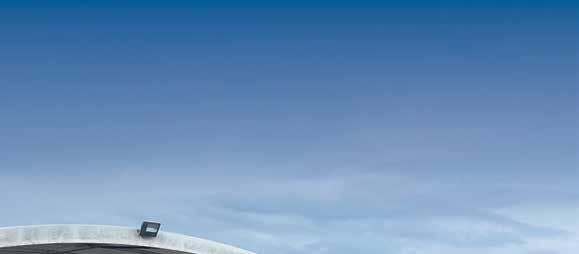
ity (which refers to the amount of water held in the soil after excess water has drained away). If effluent is added at field capacity it will likely result in ponding, runoff or leaching.
Effluent spreading New Zealand’s dairy farm systems produce a large amount of nutrientrich effluent which is captured from milking sheds, holding yards, feed pads,
standoff pads, and animal shelters.
The average dairy cow produces about $25 worth of nutrients annually as farm dairy effluent (FDE). For a 400-cow dairy herd this represents about $10,000 of nutrients annually. Using effluent to supplement fertiliser presents an opportunity to capitalise on a cost-effective nutrient resource while

improving whole farm nutrient use efficiency.
Effluent is commonly grouped into three broad categories based on dry matter (DM) content: liquids (0–5%), slurries (5–15%) and solids (>15%).
Application of effluents is typically via land. Effluent application to pasture
To get good value out of effluent and reduce

environmental risk consider:
■ Timing of application – The best way to ensure that plants can take up nutrients from effluent is to only spread it when there is sufficient soil moisture deficit / capacity available in the soil. If the soil is too wet there will be leaching or run off.
■ Rate of application/ depth of application – Good practice involves ensuring the effluent is applied at a rate that can infiltrate the soil and not pond or run off, drainage beyond the plant roots is avoided and it is spread evenly.
■ Where possible, leave a buffer strip next to waterways and farm boundaries and know your consent conditions and/or regional rules.
Article by DairyNZ











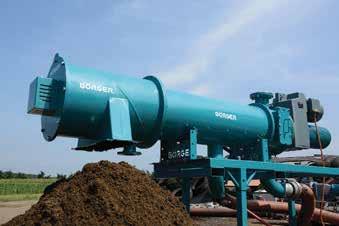






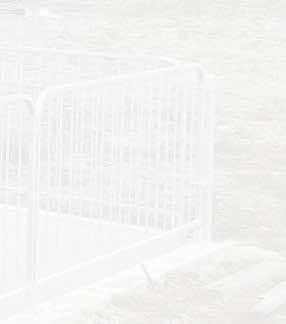







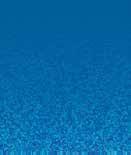

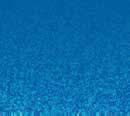




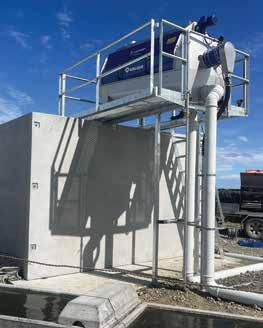




between the tractor hitch and the axle.
DISTRIBUTED IN New Zealand by Norwood, Pichon has expanded its SV effluent tanker range with the addition of the new SV12R single-axle and SV15R tandem-axle models.
The SV12R model offers a capacity of 12.2 cubic metres, and is the first single-axle model to join the SV liquid spreader series.
A clever, movable, bolted axle on the chassis, standard on this model, allows optimal distribution of loads
This is said to improve traction and driver comfort, irrespective of the final applicator, be it a spreader plate, dribble bar or disc-injection assembly.
Recessing the axles under the tanker body allows the fitment of tyres up to a diameter of 1900mm, which in turn can help alleviate soil compaction in difficult conditions.
The larger SV15R model offers 15.6 cubic metres capacity, using a tank design that allows wheel diameters of 1680mm – said to offer
low rolling resistance and reduced fuel consumption.
The tandem axle with reinforced pivots is designed for loads of up to 15 tonnes per axle –while also being prearranged to retrofit the Teleinflationadjustable tyre inflation option – and optimises ground surface contact and preserves the soil structure.
An optional load transfer bulkhead helps the towing tractor maintain traction and grip until the load is fully emptied, without transferring rearwards off the tractor coupling – an
advantage in hilly areas.
Both models are compatible with Pichon’s wide range of application tools, including dribble booms, trailing shoes, incorporators, and injectors, alongside the BP2 auto filler arm, plunger, and turret.
SV models feature iControl terminals, which are available in joystick or a joystick version with touchscreen, while tanks come in a range of thicknesses, making it possible to attain a negative pressure close to -1 bar, which guarantees priming in difficult conditions and greater reception pit depths.
CHOOSING THE right effluent system requires professional advice, considering future plans, and picking the right person for the job.
When making the decision to install or upgrade a farm dairy effluent system it’s important to ask the right questions, gather information and take professional advice.
You want the system to work well for many milking seasons to come so it’s important to consider the following:
■ Find the right person for the job
■ Establish your system requirements
■ Make sure future plans are taken into account Planning the right system is important .
One system is the travelling irrigator – the traditional design with
a stormwater diversion in place at the yard. The effluent flows from the yard through a stone trap to a storage facility either via gravity feed or pump. It is then irrigated to land using a travelling irrigator. It’s best suited for farms with no landscape/ climate/ soil risk factors, freely drained soils, flat to gently sloping ground, moderate labour input and also for regular shaped paddocks
Another system is the low-rate sprinkler with mechanical separation.
This system has a storm water diversion at the yard. The effluent then flows through a stone trap to a mechanical separator where the solids are removed. The liquid is then pumped to storage and irrigated to land via a small number of low-rate applicators that are moved frequently.
This is best suited for farms that require flexibility in application depth and rate, such as high-risk soils, high rainfall areas or sensitive catchments, especially suited to poorly drained or artificially drained soils, all slopes and works well in small or irregular paddocks.
The muck spreader system typically includes a storm water diversion then flow through a stone trap to a storage facility. A pump station is required if there is no gravity to storage. Effluent is stirred and sucked from storage into a muck spreader truck and sprayed to land
This is best suited for smaller farms and lower cow numbers, or when applying effluent to remote areas, all types of soils and flat to sloping land.
Article by DairyNZ


IT ALL started with one native plant. It was 1996 and Taranaki Regional Council had just launched its ground-breaking riparian management programme to help protect the region’s waterways.
That first plant left the depot and was planted on one of Taranaki’s hundreds of rivers and streams. This marked the beginning of one of New Zealand’s most successful collaboration programmes between farmers, the community and the council to improve the quality of freshwater and ecosystems.
Some 28 years later, a major milestone has been reached with the eight millionth plant now planted by a farmer on a riparian margin
The programme is the largest revegetation project in the country on private land with an incredible 5385km of planting across the ring plain.
TRC land services

manager Don Shearman, who started running the programme when it was launched, says the council is proud of the scheme’s positive impact, not only on water quality, but on the ‘transformation of the landscape’ and on the region’s ecosystems and biodiversity, particularly the establishment of new native habitat.
“We’re delighted to have reached another landmark with the number of riparian plants now distributed to farmers in Taranaki at more than eight million,” says Shearman.
“We couldn’t have achieved this result without working together with the farming community and all the other
property-specific riparian management plans and provide recommendations and technical advice on where to fence and how to plant waterways with the right plant in the right place.
Through a tender system, contracts for growing native plants in bulk are awarded to commercial nurseries a year in advance of planting so that they have time to grow.














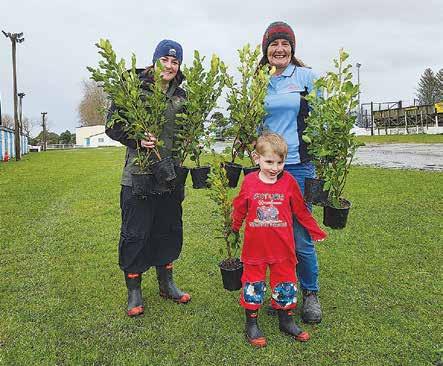
stakeholders who have an interest in freshwater quality. Collaboration and clearly defined roles have been the key reason why the region now has thousands of kilometres of new riparian planting as well as thousands of kilometres of new fencing.
“It’s by far the most successful voluntary fencing and planting programme in the country without ratepayer subsidies and we believe it’s made a significant improvement to ecosystems and water quality.
“We’re also looking forward to seeing further water quality improvements when those eight million plants have matured and the remaining margins have all been fenced and planted adequately.
“However, we know with the Government’s
■ In order to launch the programme, the council launched the riparian management strategy in 1993
■ This established a bulk supply of plants with 14,000 available when the scheme started three years later
■ The riparian scheme hit the two million-plant milestone in 2011
■ A record 985,239 plants were put through the scheme in 2021, with assistance from the Government’s Jobs For Nature programmes
■ Around 7000km of new fencing has been erected by landowners to protect new plantings and to exclude stock from waterways since the scheme was launched
■ 99 5% of Taranaki’s 1600 dairy farms have riparian plans
■ It has been recognised with a Green Ribbon Award from the Ministry for the Environment, and awards from the Geospatial World Forum and the NZ Resource Management Law Association
new water quality standards, there’s still a huge amount of work to be done in this area, but the riparian programme has given us a strong plat-
form to build on.”
Landowners in the programme work closely with the council’s Land Management Officers (LMO) who develop free,
They are then sold on to farmers at wholesale prices for planting the following winter. To ensure the system remains efficient, the council has to ensure the right number of plants are grown each year. Therefore, landowners must now order them a year in advance and pay a small deposit to secure their order.
“We’ve been talking to our community about freshwater as we look to create a new Land and Freshwater Plan for Taranaki and we’ve had strong support for continuing the programme,” adds Shearman.
“Our ambition is to have riparian planting, where appropriate, and fencing on all rivers and streams in the ring plain and that’s something we’ll continue to work to achieve in the future.
“We started the native plant scheme with a single plant 28 years ago and now we’re at 8,142,487 plants and this doesn’t even include all the plants that farmers have bought independently or grown themselves. That’s an incredible achievement for our Riparian Management Programme.”
The focus of the programme is currently to carry out audits on all existing riparian management plans to ensure the existing plantings and buffers are working as intended. Landowners can contact their LMO at any time for advice and information. For more details or to order plants for the 2026 winter planting, email riparian@trc. govt.nz or call 0800 736 222.
THINGS ARE getting busy again in the water sector across both the agriculture and metro areas.
In response, the water data and technology company ADR/ Watermetrics says it has reorganised itself, with new capabilities and capacity, including new staff in Hamilton and Oamaru.
ADR/Watermetrics began as a water data collector and has a history in performing in this area.
The nationwide company supplies and services technology like flow meters, soil moisture and EC probes, weather stations, hydrostatic and ultrasonic level sensors.
“This equipment provides data,” it says. “This data is the base to make informed management and water use decisions.”
As an example, it says there are many cases of over watering with irrigation and it’s not unrealistic to say that accurate data can save 10-20% of the water without reducing yield. The pumping cost savings dwarf the actual data costs.
“We have specific easyto-read presentations, and a backup team to help you understand and better use the information we provide. Our data displays are clear and simple to interpret.
“We can send alerts from this data for critical points to your cell phone. This saves physical staff time, providing peace of mind for the manager.”
For example, the soils presentation clearly shows the effects of irrigation applications, helping calculate future application rates.
The company says its soil probe measures at 100mm intervals, giving in-depth detail of the soil status for moisture, salinity, and temperature. This is enhanced with
weather forecasting, crop agronomy requirements and any water supply concerns.
It notes that effluent or waste application to land is an important issue.
“The timing and amount of application is critical to how the soil will respond and any damage to adjoining waterways.
Understanding moisture levels prior to applications is critical, as is understanding the salinity, which correlates with nitrogen and other mineral levels. Specific crops perform best at certain EC levels.
“Water use data must be presented in a timely and accurate way to councils. Our staff are experienced with this and maintain a credible relationship with councils on your behalf. Verification work is undertaken with Blue Tick qualified staff and we do verification work nationally.
“With stock water we can set up tank or pond level readings with alerts. This saves a lot of farm staff time travelling to check supplies. We can work through volumes identifying wastage.”
The company says its new Axioma meters are for smaller 15-50mm pipes and can measure what water has gone into a system and see if the right amount has arrived where it should.
This is extremely helpful for leak detection work and has literally saved farmers time and money, it says.
“Many water users now need to supply clean water to their houses, apartments or rural stock water schemes. Not only can we measure and monitor tanks and flows we can set up and control clean water systems.
“This clean water aspect is growing in demand and requires the right kit for the specific situation.”
ADR/Watermetrics began as a water data collector and has a history in performing in this area.

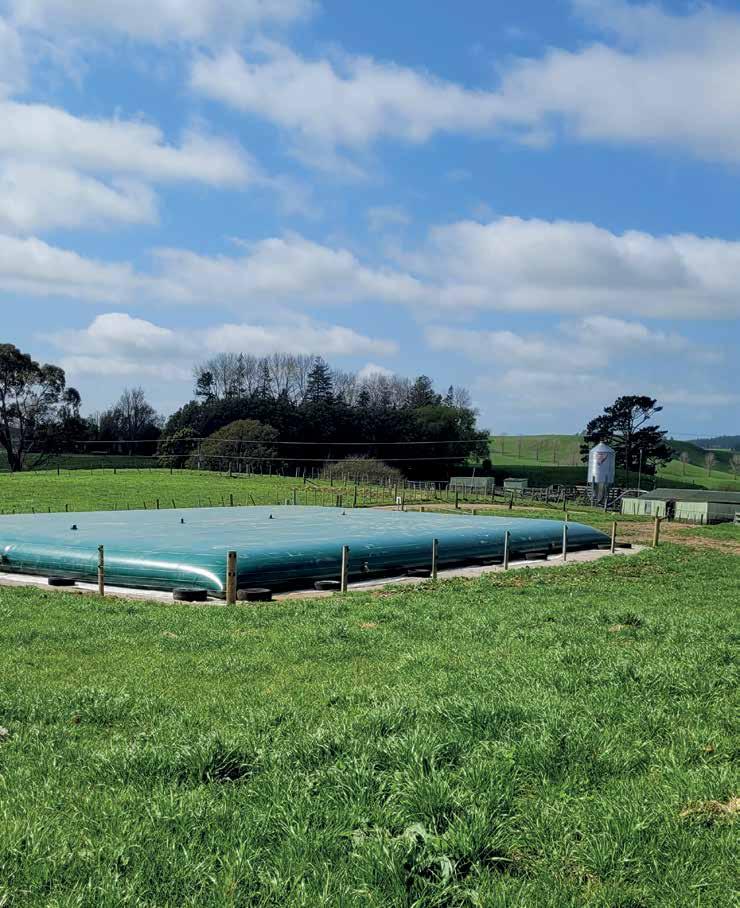
”As
the rules change, we’ve had to change with them. And we’ve changed to a system which we believe is the right one to use”
WATCH TREVOR’S CASE STUDY ONLINE nevadagroup.co.nz/infohub/videos/on-farm-case-studies

NZ’s specialist provider of DAIRY EFFLUENT MANAGEMENT SYSTEMS 0800 464 393 | nevadagroup.co.nz
EILEEN AND Shane
Walker, the driving forces behind a Kapiti Coast wetland project that’s in its fifth year, have a love for the environment that’s obvious even from a distance.
The former dairy farmers say their longterm vision is to create a recreational space the community can enjoy.
Their Parahamuti project – named after the original name for the stream that borders the wetland site – is based around the Te Horo farm Eileen and Shane lease to local dairy farmers Andrew and Stacey Faith and aims to improve water quality and increase biodiversity. Stage one saw a 1.5ha area planted in 2023, with stage two now underway and involving building fish ladders and restoring a 5ha-plus area containing native species.
DairyNZ is lending its scientific expertise to the project, which is also supported by Fonterra, the Greater Wellington Regional and Kapiti Coast District Councils, and Nga Hapu of Otaki. DairyNZ will offer support through water quality monitoring advice once stage three, which will involve constructing a wetland, begins.
“We work alongside farmers to improve waterway health, and this project has similar goals,”
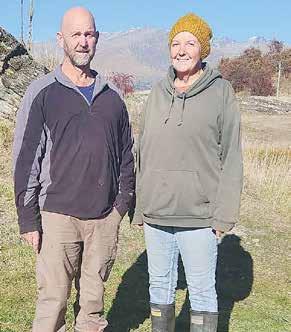
DairyNZ senior science manager Aslan WrightStow says. “We encourage farmers to invest in restoring and protecting wetlands and, where appropriate, constructing new ones because of their environmental benefits. Wetlands can boost biodiversity, provide habitat for birds and fish and reduce contaminants such as nitrogen, phosphorus and sediment –and they look great.
“We look forward to continuing to work with Eileen and Shane, council and iwi to help accelerate positive change.”
Eileen and Shane’s interest in wetlands was sparked after attending a 2014 Rabobank seminar, where the presenter spoke about how effective wetlands can be in


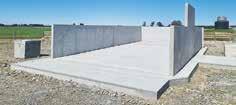


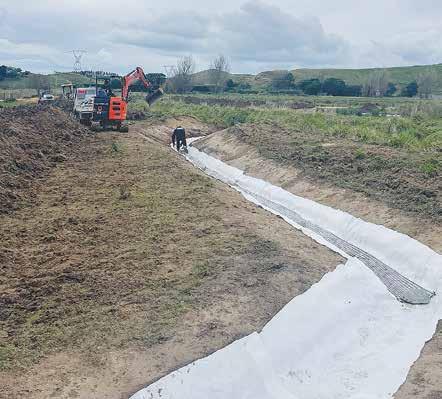
removing sediment and improving water quality. That led to a collaboration with Christine
Finnigan of the Nguturoa Catchment Group to create a wetland near Gore on land the three co-owned.
“Our drivers were to improve water quality and create a nice space

for recreational activities – kayaking, picnics etc,” Eileen says. “We wanted to do something positive.”
Off the back of that Gore project, Eileen and Shane realised a wet-
land could also suit the low-lying fields of Kapiti Coast, which flood regularly.
“A big part of this work for us is showing you can do good things alongside operating a dairy farm,” Eileen says.
The former dairy farmers now live in Arrowtown and say managing the project remotely is no easy feat.
But the Faiths support the project by allowing those working within it plenty of access, and Eileen and Shane work closely with Jamie Peryer from GWRC, who they say has been great at organising things.
“Ngā Hapū o Ōtaki has also been excited about the project and very encouraging.”
Shane grew up in Kapiti Coast and his siblings still live in the community. His brother Kerry, who lives opposite
the original home farm, has worked with GWRC on his own planting projects. The opportunity to help improve the environment he grew up in is another driver of the work for Shane.
“The home farm next to where we’re doing the wetland has been in our family for 100 years,” he says.
“It’s been a great little dairy farm and it seems like the time is right to restore the land, to return it to how it was before it was drained.”
The planned planting aims to reflect the native species that would have been on the land originally.
“Largely kahikatea,” Eileen says. “There would have been big forests there.
“Kerry has noticed with his planting there is a lot more natural spread of other native species,” Eileen says. “The more natives that go in, the more birds are attracted – and they spread seedlings. Once you’re on the right side of it, it becomes a very positive cycle.
“We hope the wetland will become home to endangered birds such as the spotless crake and the bittern.”
In keeping with their long-term vision, Eileen says she and Shane hope the wetland area will eventually include cycle, walking and bridle trails.
“We’d really like to have that.”
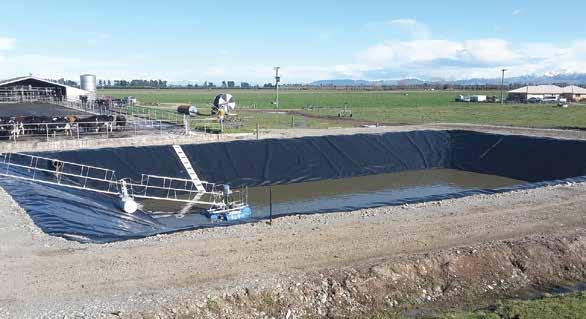


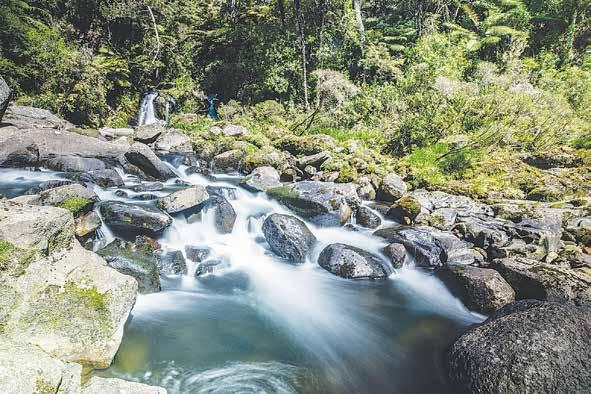
ANGLERS ARE at loggerheads with an environment group over its plans for a new conservation system.
Fish & Game New Zealand claims that a report by the Environmental Defence Society (EDS) downplaying the importance of valued introduced species such as trout and salmon is wide of the mark.
The EDS Restoring Nature report, launched last week, recommends replacing the Wildlife Act and Conservation Act with a new law that gives greater priority to threatened and indigenous species over valued introduced species.
“We accept the need to reform the Wildlife and Conservation Acts and acknowledge the report has some sound recommendations. However, overall, it demonises valued introduced species,” says Corina Jordan, chief executive of Fish & Game New Zealand.
“The report ignores the fact that environmental degradation, habitat loss and climate change pose the greatest challenge to threatened and indigenous species.
“If these recommendations were ever adopted, they would effectively reduce the protection of trout and salmon, which legislation has long safeguarded. These laws have recognised the national importance of valued introduced species and the reason why we need to protect their habitats – that’s to safeguard the habitat of all freshwater fish.
“By recognising these species and protecting their habitat, we are also protecting all freshwater species. That’s because trout and salmon have some of the highest freshwater quality and quantity requirements out of our freshwater species.
“It would also mean that trout or
salmon in an angler’s favourite river will be classed as ‘second class citizens’ even when indigenous species are not threatened.
“Ultimately, these recommendations place a question mark over the future of freshwater fishing, the species we harvest for food and our critical role in managing these species and their habitats on behalf of New Zealanders.”
The EDS report called Restoring Nature: Reform of the Conservation Management System sets out a comprehensive package of recommendations for a new conservation system.
“All of our core conservation legislation predates the dual climate change and biodiversity crises. There is an urgent need to bring these laws in line with modern conservation practice, to better reflect Te Tiriti, current values and aspirations and to ensure that the system is responsive to the challenges ahead,” said report co-author Dr Deidre Koolen-Bourke.
She says the report builds on EDS’s 2023 reviews of the Wildlife Act and the Conservation Management Planning system and that it demonstrates a clear need to prioritise indigenous biodiversity, shift management towards restoration, and strengthen a science-based approach across the system.
“DOC is charged with managing around a third of our country’s land, and it contains our most iconic landscapes, and irreplaceable natural and historical heritage,” says report co-author and EDS Policy Director Raewyn Peart.
“However, the department has never been sufficiently funded to do this job. The report therefore looks closely at how [DOC] can increase its income.
“Our recommendations are designed to provide a starting point for a national conversation on conservation reform. They highlight the critical gaps and pinch points that need to be addressed as matters of urgency. Our ageing conservation system is failing and it is crucial we get the settings right,” says Peart.
The report also explores different options for the management of introduced species, including replacing Fish & Game with a public agency similar to the former Wildlife Service or combining it with the Game Animal Council.
“Historically, Fish & Game has been the ‘last man standing’ in representing the public good in the fight to ensure New Zealand has a healthy environment people can enjoy,” says Jordan.
“Anglers and hunters are out there, off track, in New Zealand’s wild places. They’re involved in predator trapping, endangered birds’ recovery programmes and habitat enhancement. They’re among New Zealand’s greatest conservationists and really care about the environment and our iconic native species.”
EDS is also wrong to suggest valued introduced species always pose a threat to indigenous species.
“The latest scientific research demonstrates native fish and trout can co-exist with careful management. What’s most important is habitat quality over competition for food.
“The overlap between trout and vulnerable species is, in fact, limited. Any impact is localised to a fraction of New Zealand’s waterways. Habitat degradation has been identified as a more significant threat than trout predation.
without integral loading arms.
A RELATIVELY young company, founded in Germany in 1977 by Josef Fliegl Senior, the Fliegl Group now employs more than 1100 workers.
While offering an expansive range of transport solutions, from their base east of Munich in Bavaria, the company is also heavily involved in handling liquid effluents, with a range of tankers including basic farmer models, through to high spec, high output contractor units.
Imported and distributed in New Zealand by the Power Farming Group, the Maxx Line Standard range is available ex-stock with 8600 or 10,600litre capacities, with or
They have fully galvanised tanks and chassis, the tanks featuring integral baffles. Large section tyres help protect against damage to swards, while a hydraulic braking system means the tanker is always kept under control.
An 11,000-litre per minute pump assembly on the base machine uses a 6-inch suction intake, while the machine fitted with the integral boom loading system has an 8-inch diameter intake for faster filling and turnaround. Both capacity machines feature a sprung drawbar assembly, working in conjunction with an un-sprung single axle.
Standard equipment includes a silenced pump/ compressor assembly, fill

level indicators, hydraulic changeover valve for filling or emptying, double siphons and a full lighting kit.
Elsewhere in the extensive range, double and triple axle layouts complement capacities of 3000 to 27,500-litres
within the MaxxLine, Maxxline Plus and AlphaLine families.
Offered with a choice of discharge/spreading options, the entrylevel splash plate can be upgraded to the highlevel impact head unit that can help reduce
nitrate losses by up to 30%. For those looking for better utilisation and more accurate application, more specialised trailing shoe and disc injection methods are available.
Both application systems are “fed” by a
We connect your water meter data with climate, soil moisture to give a real basis to irrigate or use water with:
• The right amount
• Tailored Presentation
• Real Time Data
• Action Alerts
• Mobile Friendly
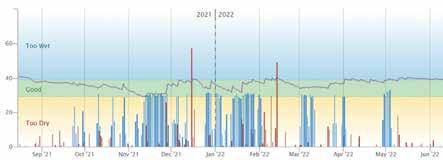
• Tank level – Axroma meters - pipe 15-50mm
to us about: Water
• At the right time Clients
• Good Value... cost effective data
• Easy setup and easy to use
screw auger system that uses dedicated traps to remove foreign objects and solid materials, including stones, to avoid blockages in the delivery hoses.
The Skate Drag Shoe applicator improves on conventional trailing
shoe set-ups by offering a block pressure of up to 8kg per shoe. It also features mechanical or hydraulically activated section control, and 250mm hose spacing. A comfort function offers automatic folding and headland turns, while also incorporating an anti-drip stop feature when folded.
The Vari-Disc injection system allows operators to incorporate effluent in the top 5 to 10cm of the soil profile, offering easy access of nutrients to plants, while also eliminating odours in sensitive areas. Using 530mm diameter, angled, springloaded discs, the unit is available in 3m, 5.56m and 7.15m operating widths, with 11, 22 and 28 outlets, each unit folding to less than 3m width for transport.
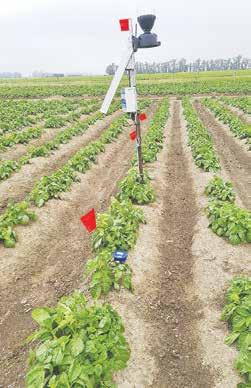
• Uncomplicated presentation giving simple farm management decisions
• Nationwide service and backup
• We are well established being the leading provider of water measuring systems
• Equipment is reliable land well proven to perform
• We support you in your audit and environmental reporting

SINCE ITS launch in the late 1960s, nearly 3.5 million Suzuki Jimnys have been sold worldwide, picking up numerous awards along the way.
Much like Vegemite, with lovers and passionate haters, the Jimny, with its distinctive, boxy retro looks, has carved a niche for itself in a market dominated by much larger SUVs.
While the current three-door version is cuter than Kylie Minogue, the 340mm longer fivedoor takes on a more oblong profile, perhaps signalling middle age after a six year wait since the three-door launch in 2018.
While the width and height of the five-door remains the same as the three-door, length extends to 3820mm. Despite the increased length, the rear passenger compartment still only offers two seatbelts, but

boot capacity expands to 211 litres, compared to only just 80 litres in the three-door. But what were Suzuki engineers thinking by not ensuring those rear sets could be folded flat?
It retains a ladder frame with 210mm ground clearance, but
the front suspension gets upgraded coil springs, revised shock absorber rates and a heavier duty anti-roll bar, alongside an upgrade to ventilated front disc brakes.
The 1500cc, 4-cylinder, naturally aspirated K15B multi-point injection engine has a maxi-
mum output of 75kW (100hp) at 6000rpm and peak torque of 130Nm at 4000rpm, with the manual version we spent a week with returning around 7.2 litres/100km consumption –suggesting dated technology, as it was the same number as this hack’s
despite appearing to be a little lacking in most of the current technologies, the Jimny is best described as terrier like. Throwing it at a soggy hole or slippery slope, there was never any real danger of not completing the task, thanks to its light weight and endless enthusiasm.
It’s easy to see why the Jimny is a firm favou-
be a little asthmatic, with the claimed 100hp only coming on stream in the higher reaches of the rev range. Interestingly, while it might be a few years since we reviewed the three-door, the fivedoor certainly appeared to be more of a handful on windy Manawatu days, requiring a great deal of input to keep things straight.

own hybrid Toyota Highland, an much larger vehicle.
The manual version offers five speeds with 2-high, 4-high and 4-low options. Out on the farm,
rite with seasoned offroaders as the limiting factor is mainly the driver’s ability.
Out on the open road, the vehicle now a little larger and heavier, it can
In summary, the Jimny takes you back to the times of an involved drive, with plenty of feedback through the steering wheel, tyres and the seat of your pants. If you have a family of four six-footers the Jimny is not for you, but if want to smile when you walk out onto the yard or driveway in the morning, this little SUV certainly warrants a closer look.
ADDING TO its extensive range of harvesting attachments for its Big X self-propelled harvesters, Krone has introduced a new whole-crop header, said to offer outputs of around 20% more than the existing XDisc 620 unit.
The new XDisc 710, with a cutting width of 7.1 metres, has been developed to utilise the full potential of a powerful forager more efficiently, using cutter-bar technology based on the EasyCut mower technology already employed in the XDisc 620.
In operation, the speed of the 900mm diameter integral feed auger can be optimally adjusted to the intake speed of the forage harvester in three stages, depending on the required cutting length of the crop.
A clever option, available solely for the Big X Series, is the integrated header transport chassis that eliminates the need for a separate transport trailer, so significantly reducing changeover times between paddock or site moves.
The transport chassis is equipped with a single axle on the right-hand side of the header, with the drawbar, with its folding support jack located on the opposite side. In operation,
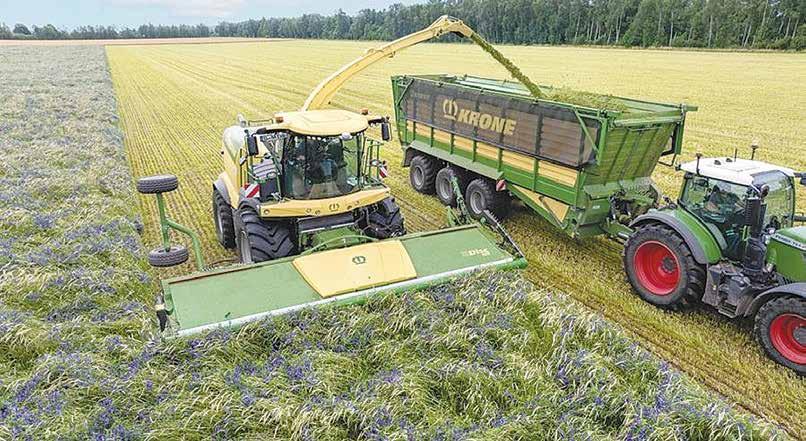
the hydraulic system has been coupled and the header raised, the driver swivels the drawbar and the axle of the running gear directly from the cab.
is attached to the

